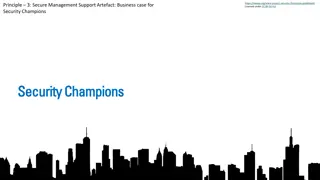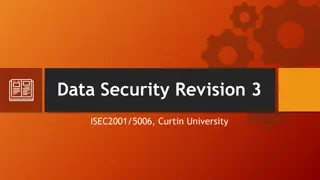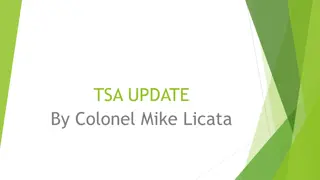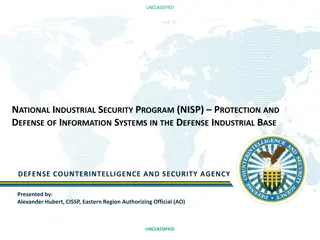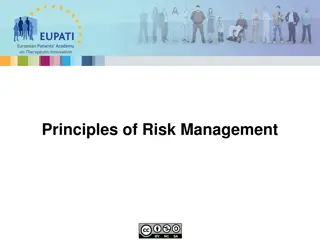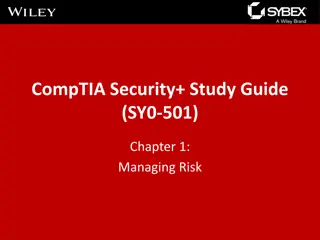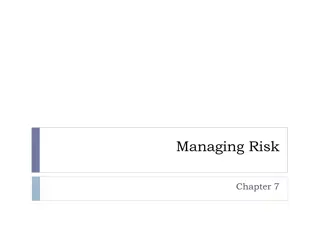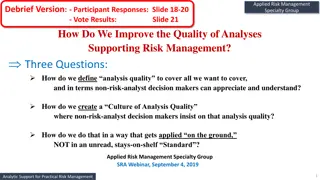Security Planning and Risk Management Overview
This content provides an in-depth exploration of managing risk, security planning, and risk appetite in the context of cybersecurity. It covers essential concepts such as risk management process, threat types, risk analysis strategies, vulnerability assessment, and risk mitigation techniques. The material emphasizes the importance of balancing security costs and potential losses, delving into risk tolerance levels and internal/external factors influencing risk management strategies.
Download Presentation

Please find below an Image/Link to download the presentation.
The content on the website is provided AS IS for your information and personal use only. It may not be sold, licensed, or shared on other websites without obtaining consent from the author.If you encounter any issues during the download, it is possible that the publisher has removed the file from their server.
You are allowed to download the files provided on this website for personal or commercial use, subject to the condition that they are used lawfully. All files are the property of their respective owners.
The content on the website is provided AS IS for your information and personal use only. It may not be sold, licensed, or shared on other websites without obtaining consent from the author.
E N D
Presentation Transcript
Managing Risk Security Planning Susan Lincke
Security Planning: An Applied Approach | 10/5/2024| 2 Objectives Students should be able to: Define risk management process: risk management, risk assessment, risk analysis, risk appetite, risk treatment, accept residual risk Define treat risk terms: risk acceptance/risk retention, risk avoidance, risk mitigation/risk reduction, risk transference Describe threat types: natural, unintentional, intentional, intentional (non-physical) Define threat agent types: hacker/crackers, criminals, terrorists, industry spies, insiders Describe risk analysis strategies: qualitative, quantitative Define vulnerability, SLE, ARO, ALE, due diligence, due care
Security Planning: An Applied Approach | 10/5/2024| 3 How Much to Invest in Security? How much is too much? How much is too little? Hacker attack Internal Fraud Loss of Confidentiality Stolen data Loss of Reputation Loss of Business Penalties Legal liability Theft & Misappropriation Firewall Intrusion Detection/Prevention Guard Biometrics Virtual Private Network Encrypted Data & Transmission Card Readers Policies & Procedures Audit & Control Testing Antivirus / Spyware Wireless Security Security is a Balancing Act between Security Costs & Losses
Security Planning: An Applied Approach | 10/5/2024 | 4 Risk Management Structure External Factors Internal Factors Risk Mgmt Strategies are determined by both internal & external factors Risk Tolerance or Appetite: The level of risk that management is comfortable with
Security Planning: An Applied Approach | 10/5/2024 | 5 Risk Appetite Do you operate your computer with or without antivirus software? Do you have antispyware? Do you open emails with forwarded attachments from friends or follow questionable web links? Have you ever given your bank account information to a foreign emailer to make $$$? What is your risk appetite? If liberal, is it due to risk acceptance or ignorance? Companies too have risk appetites, decided after evaluating risk
Security Planning: An Applied Approach | 10/5/2024 | 6 Risk Management Process
Security Planning: An Applied Approach | 10/5/2024 | 7 Continuous Risk Mgmt Process Risks change with time as business & environment changes Controls degrade over time and are subject to failure Countermeasures may open new risks Risk Appetite Identify & Assess Risks Develop Risk Mgmt Plan Proactive Monitoring Implement Risk Mgmt Plan
Security Planning: An Applied Approach | 10/5/2024 | 8 Risk Assessment Overview Assign value to assets Five Steps include: 1.Assign Values to Assets: Determine loss due to threats & vulnerabilities Where are the Crown Jewels? 2.Determine Loss due to Threats & Vulnerabilities Confidentiality, Integrity, Availability 3.Estimate Likelihood of Exploitation Estimate likelihood of exploitation Weekly, monthly, 1 year, 10 years? 4.Compute Expected Loss Compute Expected Loss Loss = Downtime + Recovery + Liability + Replacement Risk Exposure = ProbabilityOfVulnerability * $Loss 5.Treat Risk Treat Risk Reduce, Transfer, Avoid or Accept Risk Risk Leverage = (Risk exposure before reduction) (risk exposure after reduction) / (cost of risk reduction) Manage & Communicate Risk
Security Planning: An Applied Approach | 10/5/2024 | 9 Step 1: Determine Value of Assets Identify & Determine Value of Assets (Crown Jewels): Assets include: IT-Related: Information/data, hardware, software, services, documents, personnel Other: Buildings, inventory, cash, reputation, sales opportunities What is the value of this asset to the company? How much of our income can we attribute to this asset? How much would it cost to recover this? How much liability would we be subject to if the asset were compromised?
Security Planning: An Applied Approach | 10/5/2024 | 10 Determine Cost of Assets Costs Tangible $ Intangible: High/Med/Low Sales Risk: Risk: Replacement Cost= Cost of loss of integrity= Cost of loss of availability= Cost of loss of confidentiality= Replacement Cost= Cost of loss of integrity= Cost of loss of availability= Cost of loss of confidentiality= Product A Product B Risk: Replacement Cost= Cost of loss of integrity= Cost of loss of availability= Cost of loss of confidentiality= Product C
Security Planning: An Applied Approach | 10/5/2024 | 11 Step 2: Determine Loss Due to Threats Physical Threats Human Threats Ethical/Criminal: Fraud, espionage, hacking, social engineering, identity theft, malware, vandalism, denial of service Natural: Flood, fire, cyclones, hail/snow, plagues and earthquakes Unintentional: Fire, water, building damage/collapse, loss of utility services and equipment failure External Environmental: industry competition, contract failure, or changes in market, politics, regulation or tech. Intentional: Fire, water, theft and vandalism Internal: management error, IT complexity, organization immaturity, accidental data loss, mistakes, software defects, incompetence and poor risk evaluation
Security Planning: An Applied Approach | 10/5/2024 | 12 Security Vocabulary Asset: Diamonds Threat: Theft Vulnerability: Open door or windows Threat agent: Burglar Owner: Those accountable or who value the asset Risk: Danger to assets $ $ Thief
Security Planning: An Applied Approach | 10/5/2024 | 13 Threat Agent Types Hackers/ Crackers Challenge, rebellion Unauthorized access Financial gain, Disclosure, destruction of info. Spying, destruction, revenge, extortion Fraud, computer crimes Criminals Terrorists/ Hostile Intel. Service Industry Spies DOS, info warfare Info theft, econ. exploitation Fraud/ theft, malware, abuse Competitive advantage Opportunity, personal issues Insiders
Security Planning: An Applied Approach | 10/5/2024 | 14 Step 2: Determine Threats Due to Vulnerabilities System Vulnerabilities Coding Problems: Security ignorance, poorly-defined requirements, defective software, unprotected communication Misinterpretation: Poorly-defined procedures, employee error, Insufficient staff, Inadequate mgmt, Inadequate compliance enforcement Physical Vulnerabilities: Fire, flood, negligence, theft, kicked terminals, no redundancy Behavioral: Disgruntled employee, uncontrolled processes, poor network design, improperly configured equipment
Security Planning: An Applied Approach | 10/5/2024 | 15 Matrix of Loss Scenario (taken from CISM Exhibit 2.16) Size of Loss Repu- tation Law- suit Loss Fines/ Reg. Loss $1M- $35M Mar- ket Loss Exp. Yearly Loss $10M Hacker steals customer data; publicly blackmails company Employee steals strategic plan; sells data to competitor Backup tapes and Cust. data found in garbage; makes front-page news Contractor steals employee data; sells data to hackers 1-10K Recor ds 3-year Min. $1M- $20M $1M- $10M $1M- $5M Min. Min. $20M $2M 10M Recor ds 10K Recor ds $20M $20M $10M $5M $200K $5M $10M Min. Min. $200K
Security Planning: An Applied Approach | 10/5/2024 | 16 Regional Risks Region Top Attack Types (Verizon 2022) Motive Nation Average Cost of Breach (in millions) (IBM 2022) $9.44 $5.64 (Verizon 2022) North America System intrusion Social engineering Web app attacks Social engineering System intrusion Web app attacks Financial: 96% Espionage: 3% Grudge: 1% Financial: 79% Espionage: 21% United States Canada Europe- Africa Middle East Western E.U. nations U.K. Scandinavia Japan ASEAN- Australia India Latin America Brazil $7.46 $3.74-$4.85 $5.75 $2.08 $4.57 Asia Pacific Social engineering Web app attacks System intrusion Financial: 54% Espionage: 46% $2.87-$2.92 $2.32 $2.80 $1.38 Latin & South America System intrusion Denial of service Social engineering Financial: 92% Convenience: 3% Espionage: 2% Grudge: 2%
Security Planning: An Applied Approach | 10/5/2024 | 17 IBM Cost of a Data Breach Report (IBM, Ponemon) 2021, 2022 Category Most Common Initial Attack Vector Avg. Cost per Breach Type (in millions) Data breach cost total [IBM22] Stolen or compromised credentials (19%) $4.50 Phishing (16%) $4.91 Cloud misconfiguration (15%) $4.14 Third party software vulnerability (13%) $4.55 Average Breach Cost $4.35 Mega breach cost [IBM21] 1 million-10 million records breached $52 50 million-65 million records breached $401
Security Planning: An Applied Approach | 10/5/2024 | 18 2021 Cost of Data Breach Statistics (Ponemon, IBM) Industry Cost of Breach (in millions) $3.62 $3.7 $3.79 $4.65 $5.72 $9.23 $3.03 $4.24 $3.17 $5.04 $1.93 $3.6 $3.27 $4.65 $4.88 $3.75 Communications Consumer Education Energy Financial Health care Hospitality Industry Media Pharmaceutical Public sector Research Retail Services Technology Transportation
Security Planning: An Applied Approach | 10/5/2024 | 19 Step 1: Determine Value of Assets Step 2: Determine Loss due to Threats Work book Asset Name $ Value Direct Loss: Replacement $2,000 per student (tuition) $ Value Confidentiality, Integrity, and Availability Notes Consequential Financial Loss Student(s) and/or Instructor(s) Lawsuit= $1 Million Investigation costs= $100,000 Reputation= $400,000 (E.g.,) School Shooting: Availability (of persons lives) Issues may arise if we should have removed a potentially harmful student, or did not act fast enough. Registration Server $10,000 Breach Cost (low estimate)=$644,000 Registration loss per day =$16,000 Affects: Confidentiality, Availability. Conf=> Breach Notification Law =>Possible FERPA Violation =>Forensic Help Availability=> Loss of Registrations Affects: Confidentiality, Integrity. Integrity => Student Lawsuit Confidentiality => FERPA violation Both => Forensic help Grades Server $10,000 Lawsuit = $1 million FERPA = $1 million Forensic help = $100,000
Security Planning: An Applied Approach | 10/5/2024 | 20 Consequential Financial Loss Calculations Consequential Financial Loss Total Loss Calculations or Notes Lost business for Lost business for one day (1D) one day (1D) Breach Cost Breach Cost 1D=$16,000 Registration = $0-500,000 per day in income (avg. $16,000) IBM Breach Cost Estimate using per record cost= $161* x 4000 Students =$644,000 OR maximum estimate for education industry: IBM Breach Cost: $3.79 million* Comprehensive number includes forensic help (* from [IBM21]) $644,000 Lawsuit Lawsuit FERPA regulation FERPA regulation $1 Million $1 Million Student lawsuit may result as a liability. Violation of FERPA regulation can lead to loss of government aid, assumes negligence.
Security Planning: An Applied Approach | 10/5/2024 | 21 Step 3: Estimate Likelihood of Exploitation Best sources: Past experience National & international standards & guidelines: NIPC, OIG, FedCIRC, mass media Specialists and expert advice Economic, engineering, or other models Market research & analysis Experiments & prototypes If no good numbers emerge, estimates can be used, if management is notified of guesswork Assign value to assets Determine loss due to threats & vulnerabilities Estimate likelihood of exploitation Compute Expected Loss Treat Risk Manage & Communicate Risk
Security Planning: An Applied Approach | 10/5/2024 | 22 Historical Rate of Breach (2-year average) Nation Breach % ASEAN (includes Indonesia, Singapore) 26.6% Brazil 43% Canada 18.2% Germany 14.3% India 34.7% Japan 21.9% Middle-east 32.6% South Africa 40.9% United Kingdom 27.2% United States 2018 Cost of Data Breach Statistics (Ponemon, IBM) 26.9%
Security Planning: An Applied Approach | 10/5/2024 | 23 Security Attacks by Industry Verizon Data Breach Investigations Report 2022 Attack Source Accommod ation, Food services Motive Top attack types System intrusion Social engineering Web app attacks System intrusion Web app attacks Errors Compromised data Credentials: 45% Personal: 45% Payment: 41% Other: 18% Personal: 63% Credentials: 41% Other: 23% Internal: 10% Personal: 66% Credentials: 49% Other: 23% Medical: 15% Personal:71% Credentials: 40% Other 27% Bank: 22% Personal: 58% Medical: 46% Credentials: 29% Other: 29% External: 90% Internal: 10% Financial: 91% Espionage: 9% Education External: 75% Internal: 25% Financial: 95% Espionage: 5% Entertain- ment, Recreation External: 74% Internal: 26% Financial: 97% Grudge: 3% Web app attacks System intrusion Errors Finance, Insurance External: 73% Internal: 27% Financial: 95% Espionage: 5% Web app attacks System intrusion Errors Healthcare External: 61% Internal: 39% Financial: 95% Espionage: 4% Web app attacks Errors System intrusion Adapted from: 2018 Data Breach Investigations Report (Verizon) Convenience: 1% Grudge: 1%
Security Planning: An Applied Approach | 10/5/2024 | 24 Security Attacks by Industry (continued) Verizon Data Breach Investigations Report 2022 Information External: 76% Internal: 24% Financial: 78% Espionage: 20% Ideology: 1% Grudge: 1% Financial: 88% Espionage: 11% Grudge: 1% Secondary: 1% Financial: 78% Espionage: 22% System intrusion Web app attack Errors Personal: 66% Other: 35% Credentials: 27% Internal: 17% Personal: 58% Credentials: 40% Other: 36% Internal: 14% Credentials: 73% Personal:22% Internal: 9% Credentials: 56% Personal: 48% Other: 26% Internal: 14% Personal: 46% Credentials: 34% Other: 28% Internal: 28% Credentials: 45% Personal: 27% Other: 25% Payment: 24% Credentials: 93% Internal: 4% Bank: 2% Personal: 2% Manufacturing External: 88% Internal: 12% Partner: 1% System intrusion Web app attack Social engineering Mining, Utilities External: 96% Internal: 4% Social engineering System intrusion Web app attacks System intrusion Web app attacks Social engineering Professional Services External: 84% Internal: 17% Multiple: 1% Financial: 90% Espionage: 10% Public Admin External: 78% Internal: 22% Financial: 80% Espionage: 18% Ideology: 1% Grudge: 1% Financial: 98% Espionage: 2% System intrusion Errors Web app attacks Retail External: 87% Internal: 13% System intrusion Social engineering Web app attacks Very Small Business External: 69% Internal: 34% Multiple: 3% Financial: 100% System intrusion Social engineering Privilege misuse
Security Planning: An Applied Approach | 10/5/2024 | 25 Step 4: Compute Expected Loss Risk Analysis Strategies Assign value to assets Qualitative: Prioritizes risks so that highest risks can be addressed first Based on judgment, intuition, and experience May factor in reputation, goodwill, nontangibles Determine loss due to threats & vulnerabilities Estimate likelihood of exploitation Compute Expected Loss Quantitative: Measures approximate cost of impact in financial terms Semiquantitative: Combination of Qualitative & Quantitative techniques Treat Risk Manage & Communicate Risk
Security Planning: An Applied Approach | 10/5/2024 | 26 Step 4: Compute Loss Using Qualitative Analysis Assign value to assets Determine loss due to threats & vulnerabilities Qualitative Analysis is used: As a preliminary look at risk With non-tangibles, such as reputation, image -> market share, share value When there is insufficient information to perform a more quantified analysis Estimate likelihood of exploitation Compute Expected Loss Treat Risk Manage & Communicate Risk
Security Planning: An Applied Approach | 10/5/2024 | 27 Work book Vulnerability Assessment Quadrant Map (part of Qualitative Risk Analysis) 2 Threat (Probability) Hacker/Criminal Malware 1 Snow emergency Intruder Disgruntled Employee Vulnerability (Severity) Flood Spy Fire 4 3 Terrorist
Security Planning: An Applied Approach | 10/5/2024 | 28 Step 4: Compute Loss Using Semi-Quantitative Analysis Impact 1. Insignificant: No meaningful impact 2. Minor: Impacts a small part of the business, < $1M 3. Major: Impacts company brand, >$1M 4. Material: Requires external reporting, >$200M 5. Catastrophic: Failure or downsizing of company Likelihood 1. Rare 2. Unlikely: Not seen within the last 5 years 3. Moderate: Occurred in last 5 years, but not in last year 4. Likely: Occurred in last year 5. Frequent: Occurs on a regular basis Risk = Impact * Likelihood
Security Planning: An Applied Approach | 10/5/2024 | 29 SemiQuantitative Impact Matrix Catastrophic (5) Material (4) Major (3) Impact Minor (2) Insignificant (1) Rare(1) Unlikely(2) Moderate(3) Likely (4) Frequent(5) Likelihood
Security Planning: An Applied Approach | 10/5/2024 | 30 Step 4: Compute Loss Using Quantitative Analysis Single Loss Expectancy (SLE): The cost to the organization if one threat occurs once Eg. Stolen laptop= Replacement cost + Cost of installation of special software and data Assumes no liability SLE = Asset Value (AV) x Exposure Factor (EF) With Stolen Laptop EF > 1.0 Annualized Rate of Occurrence (ARO): Probability or frequency of the threat occurring in one year If a fire occurs once every 25 years, ARO=1/25 Annual Loss Expectancy (ALE): The annual expected financial loss to an asset, resulting from a specific threat ALE = SLE x ARO
Security Planning: An Applied Approach | 10/5/2024 | 31 Risk Assessment Using Quantitative Analysis Quantitative: Cost of HIPAA accident with insufficient protections SLE = $50K + (1 year in jail:) $100K = $150K Plus loss of reputation Estimate of Time = 10 years or less = 0.1 Annualized Loss Expectancy (ALE)= $150K x .1 =$15K
Security Planning: An Applied Approach | 10/5/2024 | 32 Annualized Loss Expectancy Asset Value-> 1 Yr 5 Yrs 10 Yrs 20 Yrs $1K $10K $100K $1M 1K 200 100 50 10K 2K 1K 1K 100K 20K 10K 5K 1000K 200K 100K 50K Asset Costs $10K Risk of Loss 20% per Year Over 5 years, average loss = $10K Spend up to $2K each year to prevent loss
Security Planning: An Applied Approach | 10/5/2024 | 33 Quantitative Risk Work book Asset Threat Single Loss Expectancy (SLE) Annualized Rate of Occurrence (ARO) 0.2 (5 years) 0.20 (5 years) Annual Loss Expectancy (ALE) Registration Server Registration Server System or Disk Failure Hacker penetration System failure: $10,000 Registration x 2 days: $32,000 Breach Estimate: $644,000 Max: $3.7 million Registration x 2days: $32,000 $8,400 $676,000x.2 =$135,200 Max: $3.7M x.2 =$740,000 $644,000x0.05 =$32,200 Grades Server Hacker penetration Breach Estimate: $644,000 0.05 (20 years) Faculty Laptop Stolen $1,000 ______________ FERPA = $1 million Loss of Reputation 2 $2,000 (5 years * 10 instructors) 0.01 $10,000
Security Planning: An Applied Approach | 10/5/2024 | 34 Step 5: Treat Risk Assign value to assets Risk Acceptance: Handle attack when necessary E.g.: Comet hits Ignore risk if risk exposure is negligible Risk Avoidance: Stop doing risky behavior E.g.: Do not use Social Security Numbers Risk Mitigation: Implement control to minimize vulnerability E.g. Purchase & configure a firewall Risk Transference: Pay someone to assume risk for you E.g., Buy malpractice insurance (doctor) While financial impact can be transferred, legal responsibility cannot Risk Planning: Implement a set of controls Determine loss due to threats & vulnerabilities Estimate likelihood of exploitation Compute Expected Loss Treat Risk Manage & Communicate Risk
Security Planning: An Applied Approach | 10/5/2024 | 36 Controls & Countermeasures Cost of control should never exceed the expected loss assuming no control Countermeasure = Targeted Control Aimed at a specific threat or vulnerability Problem: Firewall cannot process packets fast enough due to IP packet attacks Solution: Add border router to eliminate invalid accesses
Security Planning: An Applied Approach | 10/5/2024 | 37 Analysis of Risk vs. Controls Workbook Risk ALE Score Control Cost of Control $60/device Stolen Faculty Laptop Registration System or Disk Failure Registration Hacker Penetration $2K $10,000 (FERPA) $8,400 Encryption RAID (Redundant disks) $750 $135,200 (max $740,000) Unified Threat Mgmt Firewall Log monitoring Network monitoring $1K Cost of Some Controls is shown in Case Study Appendix
Security Planning: An Applied Approach | 10/5/2024 | 38 Extra Step: Step 6: Risk Monitoring Stolen Laptop In investigation $2k, legal issues HIPAA Incident Response Cost overruns Procedure being defined incident response Internal audit investigation $200K $400K HIPAA: Physical security Training occurred $200K Security Dashboard, Heat chart or Stoplight Chart Report to Mgmt status of security Metrics showing current performance Outstanding issues Newly arising issues How handled when resolution is expected
Security Planning: An Applied Approach | 10/5/2024 | 39 Training Training shall cover: Importance of following policies & procedures Clean desk policy Incident or emergency response Authentication & access control Privacy and confidentiality Recognizing and reporting security incidents Recognizing and dealing with social engineering
Security Planning: An Applied Approach | 10/5/2024 | 40 Security Control Baselines & Metrics Baseline: A measurement of performance Metrics are regularly and consistently measured, quantifiable, inexpensively collected Leads to subsequent performance evaluation E.g. How many viruses is help desk reporting? 90 Stolen Laptop Virus/Worm % Misuse 80 70 60 50 40 30 20 10 0 Year 1 Year 2 Year 3 Year 4 (Company data - Not real)
Security Planning: An Applied Approach | 10/5/2024 | 41 Risk Management Risk Management is aligned with business strategy & direction Risk mgmt must be a joint effort between all key business units & IS Business-Driven (not Technology-Driven) Steering Committee: Sets risk management priorities Define Risk management objectives to achieve business strategy
Security Planning: An Applied Approach | 10/5/2024 | 42 Risk Management Roles Governance & Sr Mgmt: Allocate resources, assess & use risk assessment results Info. Security Mgr Develops, collaborates, and manages IS risk mgmt process Chief Info Officer IT planning, budget, performance incl. risk Business Managers (Process Owners) Make difficult decisions relating to priority to achieve business goals IT Security Practitioners Implement security requirem. into IT systems: network, system, DB, app, admin. System / Info Owners Responsible to ensure controls in place to address CIA. Sign off on changes Security Trainers Develop appropriate training materials, including risk assessment, to educate end users.
Security Planning: An Applied Approach | 10/5/2024 | 43 Due Diligence Due Diligence = Did careful risk assessment (RA) Due Care = Implemented recommended controls from RA Liability minimized if reasonable precautions taken Senior Mgmt Support
Security Planning: An Applied Approach | 10/5/2024 | 44 Risk Tolerance Table Considerations Example Table Decisions may be made per treatment class: Financial impact: A range of ALE costs for a risk Reputational impact: Impact on public perception if risk were to occur Legal impact: Adhering (or not) to a regulation or standard Qualifications for Priority Legal impact Financial impact > $N Risk Priority & Handling High Risk: Always treated Medium Risk: Negotiable Decided individually by management Reputational impact Another consideration: how may risks be handled? may they be transferred (via insurance)? must they be mitigated or avoided? Low Risk: Always accepted Financial impact < $N
Security Planning: An Applied Approach | 10/5/2024 | 45 Risk Exception Table Considerations Example Risk Exception Table High or medium priority risks may not be managed at a given time Risk Priority & Description Reason for Exception Mgmt Sign-off due to insufficient technology, finances or personnel. Risk Exceptions are then signed off on for specific unhandled risks reviewed regularly (quarterly or annually)
Security Planning: An Applied Approach | 10/5/2024 | 46 Three Ethical Risk Cases 1. On eve of doomed Challenger space shuttle launch, an executive told another: Take off your engineering hat and put on your management hat. 2. In Bhopal, India, a chemical leak killed approx. 3000 people, settlement was < 1/2 Exxon Valdez oil spill s settlement. Human life = projected income (low in developing nations) 3. The Three Mile Island nuclear disaster was a success because no lives were lost Public acceptance of nuclear technologies eroded due to the environmental problems and the proven threat It is easy to underestimate the cost of others lives, when your life is not impacted.
Security Planning: An Applied Approach | 10/5/2024 | 47 Question Risk Assessment includes: 1. The steps: risk analysis, risk treatment, risk acceptance, and risk monitoring 2. Answers the question: What risks are we prone to, and what is the financial costs of these risks? 3. Assesses controls after implementation 4. The identification, financial analysis, and prioritization of risks, and evaluation of controls
Security Planning: An Applied Approach | 10/5/2024 | 48 Question Risk Management includes: 1. The steps: risk analysis, risk treatment, risk acceptance, and risk monitoring 2. Answers the question: What risks are we prone to, and what is the financial costs of these risks? 3. Assesses controls after implementation 4. The identification, financial analysis, and prioritization of risks, and evaluation of controls
Security Planning: An Applied Approach | 10/5/2024 | 49 Question The FIRST step in Security Risk Assessment is: 1. Determine threats and vulnerabilities 2. Determine values of key assets 3. Estimate likelihood of exploitation 4. Analyze existing controls
Security Planning: An Applied Approach | 10/5/2024 | 50 Question Single Loss Expectancy refers to: The probability that an attack will occur in one year The duration of time where a loss is expected to occur (e.g., one month, one year, one decade) The cost when the risk occurs to the asset once The average cost of loss of this asset per year 1. 2. 3. 4.




